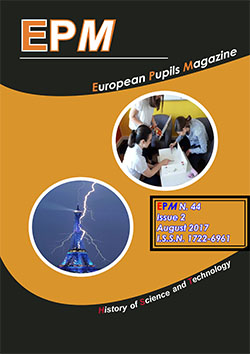Math Science Chemistry Economics Biology News Search
Born in Sibiu, Hermann Oberth has been, besides the Russian Konstantin Ţiolkovski and the American Robert Goddard, one of the three founder fathers of the Rocket Science and Austronautics.
Ever since he was 11, Hermann has discovered his passion for Jules Verne’s books, especially for the novel ”From Earth to the Moon” and ”Travel Around the World”, confessing that he had read the first one for multiple times, until he got to know it by heart.
This great man’s adolescence and youth represent a very important time in his life, as his further achievements rely on the small experiments from those times. At the age of 14, he designed the sketch of a rocket, suggesting the use of liquid fuel for this type of interplanetary vehicle.
Hermann Oberth has realised that, although the rocket fuel is consumed, by this, the weight being reduced, there still remains a tank which contained the consumed fuel, this no longer being useful from the functional point of view, thus Oberth getting to invent, without knowing the step by step fuelburning concept.
In 1922, his master degree on the Rocket Science was rejected, being considered utopian. Oberth was a critic of the educational sytem of that time, comparing it with a car with headlights turned backwards, lacking a future vision.
In 1923, Hermann Oberth published the book ”The Rocket in the Interplanetary Space”, and, in 1929, ”Ways of Travelling through Space”. In the years 1928-1929, Hermann worked in Berlin, as a scientific consultant, at the first action film from history, which was taking place in space: ”The Women from the Moon” and which had an enormous succes in the popularization of the new rocket science.
In the autumn of 1929, Hermann Oberth launched his first rocket with liquid fuel, named Kegeldüse. Hermann was assisted by the students from the Technical University from Berlin, Wernher von Braun was also among them in these experiments. For building the first biggest rocket in the world, named A4, but, nowadays, known better, under the name V2, there were used 95 of Hermann Oberth’s inventions and recommendations.
In 1938, the Oberth family moved away from Sibiu. Firstly they moved into Austria, where Hermann worked at the Technical College from Vienna, then they moved into Germany, where Hermann worked at the Technical College from Dresden, finally getting to Peenemünde (hired under the false name of Fritz Hann), where Wernher von Braun had already built the V2 rocket.
At the end of the world war, Hermann Oberth was working at WASAG complex, near Wittenberg, at rockets with solid fuel, for aerial defense. After the end of the First World War he moved with his family to Feucht, near Nürnberg.
When he was around 35, Hermann Oberth got married to Tilli Oberth (born as Hummel), with whom he had four children, from whom a boy died on the battlefield in the World War II and a girl who died soon after that, in August 1944 in a work accident.
In 1948, he worked as an independent consultant and writer in Switzerland. In 1950, he finished, in Italy, the work that he had started at WASAG. In 1953, Oberth returned to Feucht, Germany, in order to have his book entitled “Men in Space” published, a book in which he described his ideas related to space-based reflecting telescopes, space stations, electrically-powered spaceships, and spacesuits.
Meanwhile Wernher von Braun had founded an institute dedicated to space exploration in the USA, at Huntsville, Alabama which Hermann Oberth also joined. Among other things, Hermann Oberth was involved in a study called “The Space Technological Development in the Following Next 10 Years“.
At the end of 1958, Hermann Oberth, again in Feucht, found the necessary time for him to write down and to publish his thoughts related to the technological possibilities of a lunar exploration vehicle, a lunar catapult, a helicopter, a silent airplane and others.
In 1960, Oberth worked at Convair, as a technical consultant on the Atlas Rocket programme in the United States.
Hermann Oberth retired in 1962, at the age of 68. The petrol crisis, from 1977, made Oberth focus on the alternative energy sources, this leading to a plan of conceiving a wind power station that could utilize the jet stream. However, his primary interest during his retirement years was to turn to more abstract philosophical questions and he also had written some books related to this subject.
Hermann Oberth died on December 28, 1989, at the age of 95, at Feucht.
After his death, Hermann Oberth is memorialized by the Hermann Oberth Space Travel Museum in Feucht, Germany, and by the Hermann Oberth Society. The museum brings together scientists, researchers, engineers, and astronauts from the East and the West to carry on his work in rocketry and space exploration.
Bibliography
- Hans Barth: Hermann Oberth. "Vater der Raumfahrt". Autorisierte Biographie. Bechtle, Esslingen u.a. 1991.
- Boris V. Rauschenbach: German Obert 1894 - 1989. [Rossijskaja Akademija Nauk].
- Petit Robert 2, editura: Le Robert, Paris, 1991.
- Hans Barth: Hermann Oberth - Leben Werk Wirkung. Feucht: Uni-Verlag Dr. E. Roth-Oberth, 1985, 416 Seiten.
- Boris Rauschenbach: Hermann Oberth 1894-1989. Über die Erde hinaus.
- Michael Kroner: Hermann Oberth, 1934.
- Alexander Hellemans & Bryan H. Bunch: Istoria descoperirilor stiintifice, editura Orizonturi, editura Lider 1988.
- http://www.sanatatea.com
Iconography
- Boris Rauschenbach: Hermann Oberth 1894-1989. Über die Erde hinaus.
- http://www.meaus.com/articles/OBERTH.html
- http://www.produsin.ro/personalitati/herman-oberth/
- http://atlasobscura.com/place/hermann-oberth-museum


